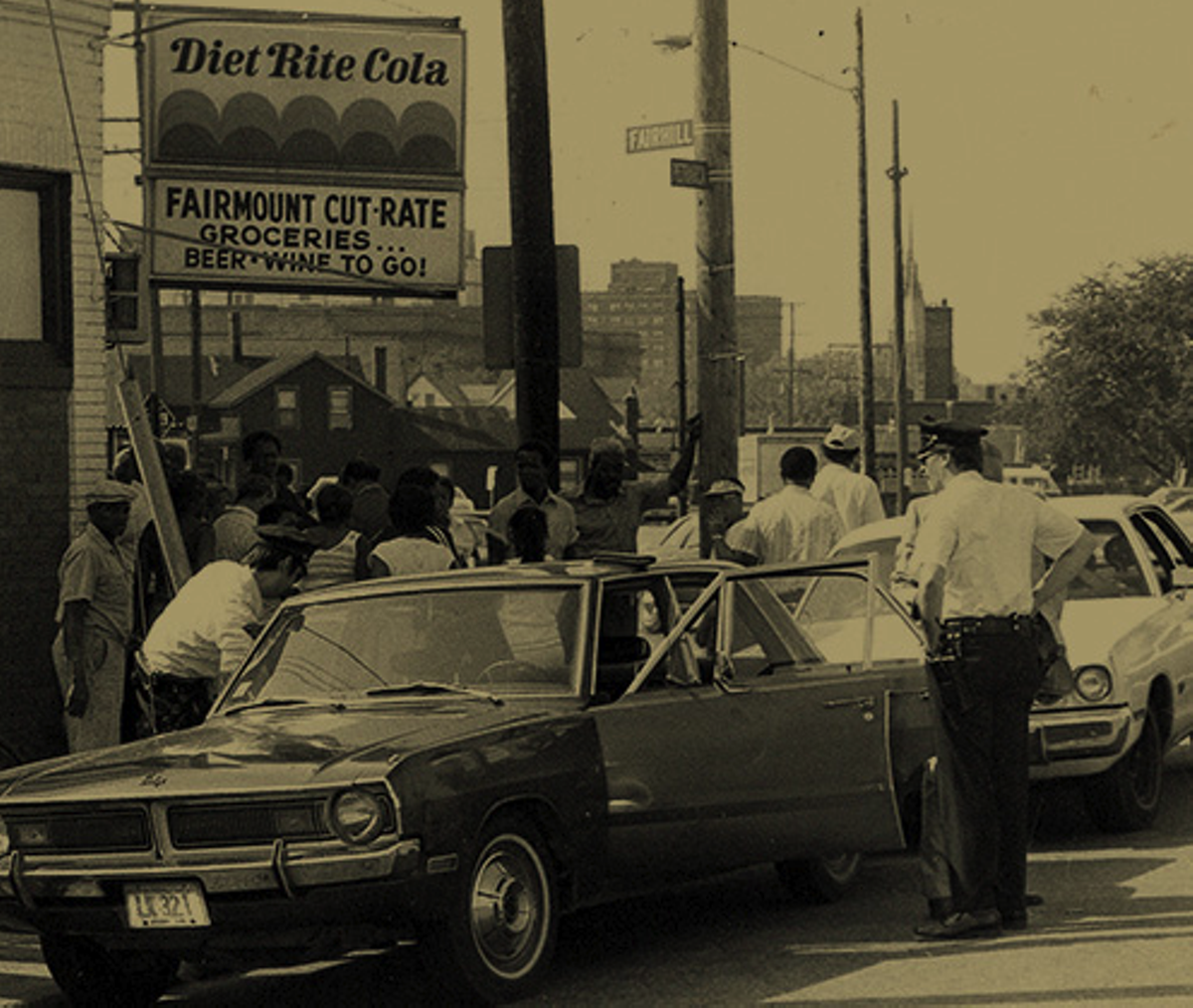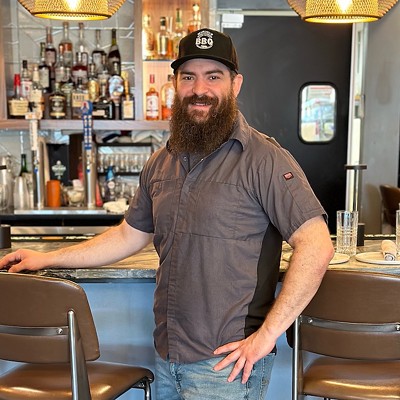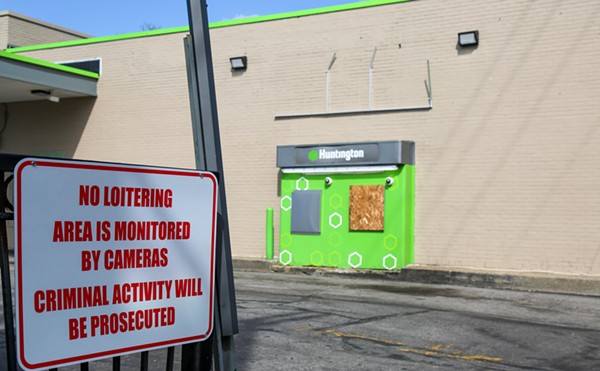***
Ronnie Bridgeman is standing again on that lonely and cracked street corner. The morning traffic up Stokes has fallen off to an occasional car. Bridgeman is looking for a bus.
"There," he says, pointing toward the stoplight at Cedar and Fairhill. Waiting to make the turn is an RTA bus, its aluminum sides shaking with the leashed motion of the engine. When the light clicks to green, the bus heaves forward and sails over the short distance from the left-turn lane on Cedar into the curbside lane on Fairhill, where it coughs to a halt at the bus stop.
"Edward Vernon said that he saw us in the car while we were turning onto Fairhill," Bridgeman says, his voice jumping along excitedly. "But you can't make that turn at the same time."
The boy testified that, before the crime, he waved at Wiley from the right side of the bus as both vehicles were turning onto Fairhill. But Cedar, then and now, has two lanes: a left-turn lane and a lane going straight. If the bus was in the turn lane, the green car would have been in the lane continuing down Cedar. If the car had turned from the right-hand lane — as Vernon claimed — there would have been little time for the car to cut off the bus before either hitting the larger vehicle or eating sidewalk.
"And if you're going to commit a crime," Bridgeman wonders aloud, "what the hell are you doing waving at somebody on the street for?"
***
Although the three young men were tried, convicted, and sentenced to death, police records show they weren't the only suspects on the radar. In fact, there was no shortage of candidates.
After the crime, a woman from the neighborhood called police to say she believed her son had been involved in the shooting. Not long after the Bridgeman and Jackson arrests, another tip came in saying they'd grabbed the wrong guys and that the men responsible were still operating in the area. The same suspect was named. The caller declined to meet with police in person, and no further communication appears to have taken place.
Records also show that, two days after the crime, a local FBI agent contacted Cleveland Police with information from "several of his informants" on the identity of the four men responsible for the robbery. Two of the men, brothers Arthur and Willie King, had previous records for stick-ups. But witnesses were only shown a picture of one of them — the suspected getaway driver. Karen Smith, who never saw the driver but only the two stick-up men, never saw photos of the others. None of the suspects named by the FBI informant were brought in for a lineup.
In court, cops also admitted they never asked whether these individuals had access to a green car matching the getaway vehicle. One detective explained from the witness stand that the reason was the FBI informant was not always reliable. On cross examination, the same officer revealed he didn't actually know the identity of the informant, so couldn't accurately assess his reliability.
***
On death row, inmates were hidden away with only their thoughts and the walls for company, 24 hours a day, minus one hour a week for recreation. When Bridgeman arrived at Lucasville in January 1976, he was given a cell four down from his brother. At the time, a current of hope still passed between them.
"Wiley — he had a bit more get-up in him," Bridgeman says today. "He was a very serious-minded person, and he spent all of his days writing, filing, trying to get help, researching the law. He was always fighting. He never gave up. But in the long run it hurt him."
In 1977, Wiley won a retrial based on a technicality in his original proceedings. But when he returned to Lucasville that fall with another guilty verdict, the strain had begun to chip away at his mind. Soon, Bridgeman was getting paranoid notes from four cells down telling him not to eat the food because it was poisoned.
In August 1978, the U.S. Supreme Court shot down the death penalty. Across the country, 97 death-row inmates walked out of isolation into the general prison pop. Wiley ended up in the psych ward. For Bridgeman, it was a toss-up whether talking to walls was worse than sharing the yard with the Lucasville prison stock. The place was notoriously brutal in the late 1970s, filled mostly with the same yard-hard convicts who had rioted at the Ohio Penitentiary in 1968. The average age in the prison was 35, with only nine inmates under 21. Bridgeman was 18.
Blood ran by the bucket. They couldn't mop it up fast enough. It was stuck to the floor, dotted the ceiling, clung to the walls, soaked your eggs during the morning meal. Each day during Bridgeman's nine years in Lucasville, someone ended up on the wrong end of a shiv. "I was afraid every day," he says, clearly troubled by the memory.
After his transfer to Lima, prison life settled somewhat. He ended up playing a lot of basketball and making a name for himself in the inmate boxing league. Later, education became his lifeboat. He earned typing and cooking degrees, became an administrator in the prison school system, and helped organize the first inmate chapter of the NAACP. But despite staying active, Bridgeman kept his mind glued to the outside, on the friends and family he'd left behind, and on the old neighborhood and what had happened there. It was easy in part because, despite the decades he ended up spending inside, the world behind the barbed wire was still foreign ground.
"I was in there with 3,000 people, but I felt like I'm just all alone by myself. The reason was, as much as day turned into night and night into day, I didn't know them cats, and I was not of the same thing they were, the same mentality," he says.
"There were guys that seemed like they were everyday people, but they weren't. They were robbers or rapists or murderers or thieves. That wasn't my mentality. I was the guy who still liked Christmas, and liked having Easter and Thanksgiving. These guys were all hardened to all that. I couldn't even say Merry Christmas to nobody because they didn't give a damn."
***
"I had no problem with the kid's testimony. It was sort of a brave act on his part," says Court of Appeals Judge James Sweeney, who served as a Cuyahoga County prosecutor on Wiley's case. Sweeney is one of the few adults involved still around. The Robinsons, the defense attorneys, the police detectives — all are either dead or couldn't be reached for comment. After all these years spent in courtrooms, Sweeney still recalls the case. "It was a horrific crime," he says. "I was not bothered by the conviction myself. I know a lot of people felt admiration for the boy."
But for the kids who grew up around Fairhill, now drifting deep into middle age, the opinion remains different.














